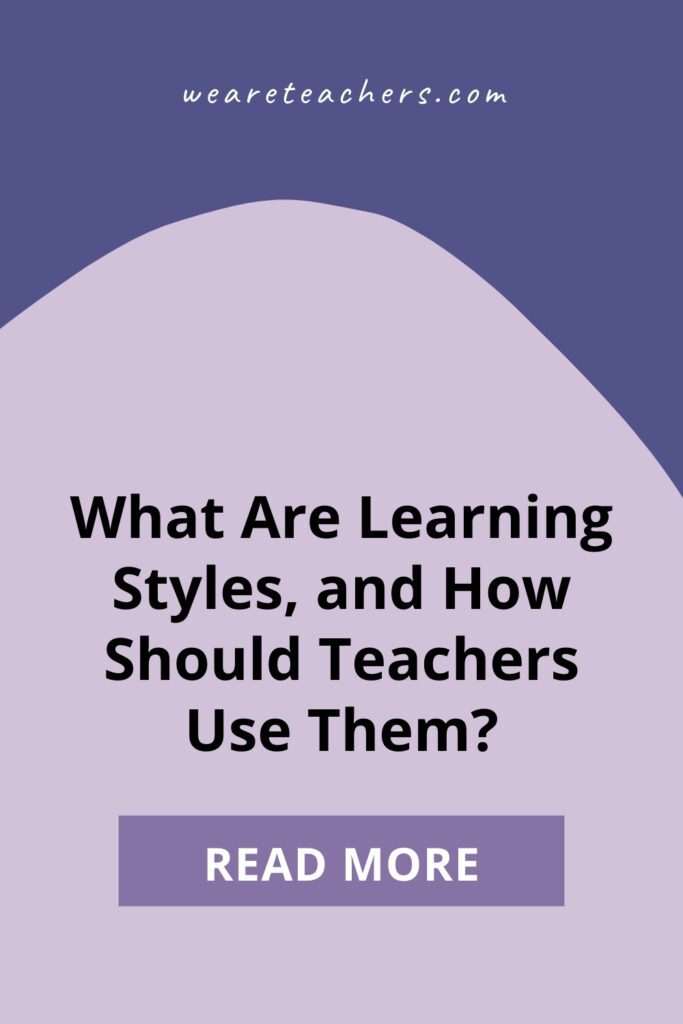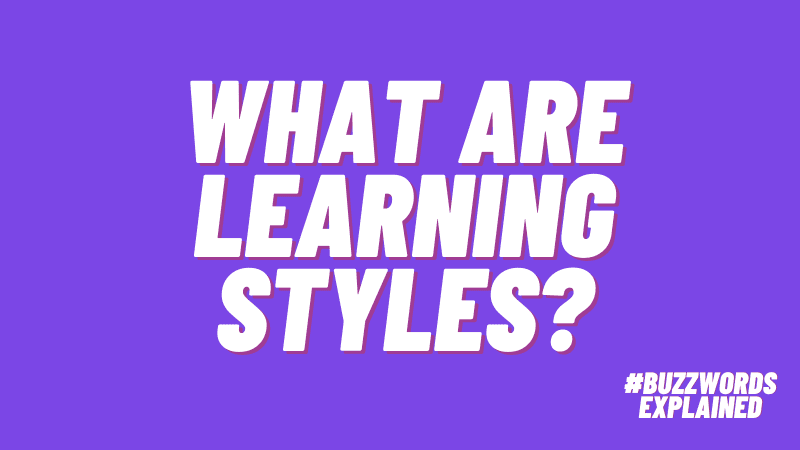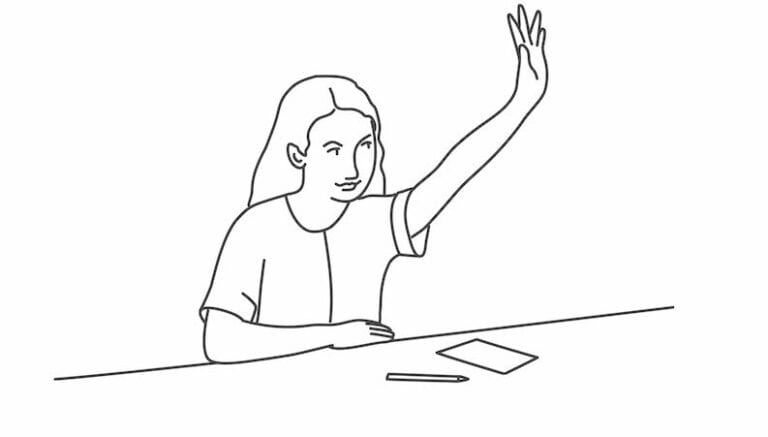Teachers are often told to make sure their lessons include a variety of activities to cover all learning styles. But what exactly does that mean?
FAQ: What Are Learning Styles?
Imagine you’re teaching a lesson on the presidency of John Adams. You’ll be giving a quiz on Friday, and you ask your students how they’ll be preparing. Some might say they’ll reread the text, then write down the answers to the review questions you’ve given them. Others might plan to watch a video on John Adams’ life, then talk over what they learned with a study partner. Another could plan to take the timeline handout you provided, cut it up into sections, and practice putting those sections in the proper order.
Each of these students is using different ways of learning in an effort to retain and understand the same information. Some like written words, some prefer to hear it and talk about it. Others need to do something with their hands, or see images and diagrams. These are all various learning styles.
What is VARK?
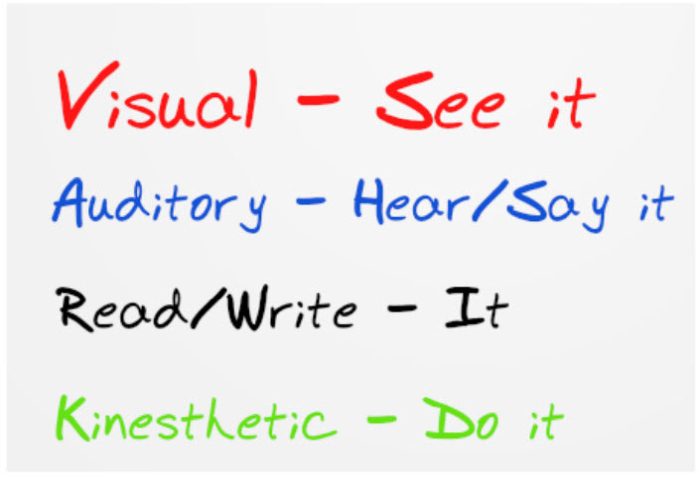
Source: Nnenna Walters
In the mid-1980s, teacher Neil Fleming introduced the VARK model of learning styles. He theorized that students learned in these four general ways, known as styles or modalities:
- Visual: Seeing images, diagrams, videos, etc.
- Auditory: Hearing lectures and having discussions
- Read/Write: Reading the written word and writing things down
- Kinesthetic: Movement and hands-on activities
Fleming developed a questionnaire (try a version of it here) that a student could take to see which learning styles they preferred. The results indicate how their learning preferences spread across the spectrum.
One important detail Fleming noted was that just because you prefer or are good at a certain learning activity, that doesn’t mean it’s actually the style that helps you learn the most. “It is possible to like something (preference) and not be good at it (skill or ability). Similarly it is possible to be very skilled at using strategies aligned with one of the VARK modalities but not use that for learning,” he explained. “As an example, a learner who was very skilled at freehand drawing did not use it for her learning and did not enjoy doing it.”
Are learning styles a proven theory?
There’s a lot of argument over the validity of learning styles. Some studies claim to have debunked the theory entirely, stating that everyone uses each of the various styles at one time or another. Critics worry that pigeonholing a student as an “auditory learner” or a “visual learner” might cause them to limit the ways they approach new material.
That said, learning styles are accepted and used in most education programs. Fleming himself published an article in 2012 defending his theory, explaining that it has been misunderstood and misused. His intention was never to limit the ways in which individual students were encouraged to learn. Rather, he wanted teachers to better understand all the different ways they could reach their students.
Does a person have just one learning style?
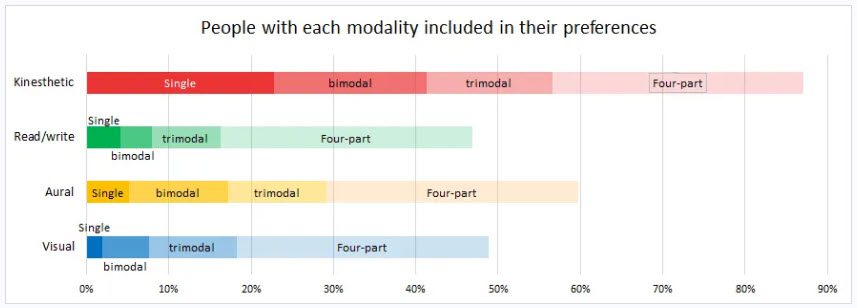
Source: VARK Research
Absolutely not, says Fleming. “Because learners have different preferences between the four modes, it is unlikely that any particular mode will be dominant. That is why multimodality is the most common profile for two-thirds of learners.”
In other words, while some people lean strongly toward one learning type (modality), most are more evenly spread across the spectrum. The way they learn best will depend on the material and situation. The key isn’t to find a single best way for a student to learn. It’s to discover all the ways all students can learn.
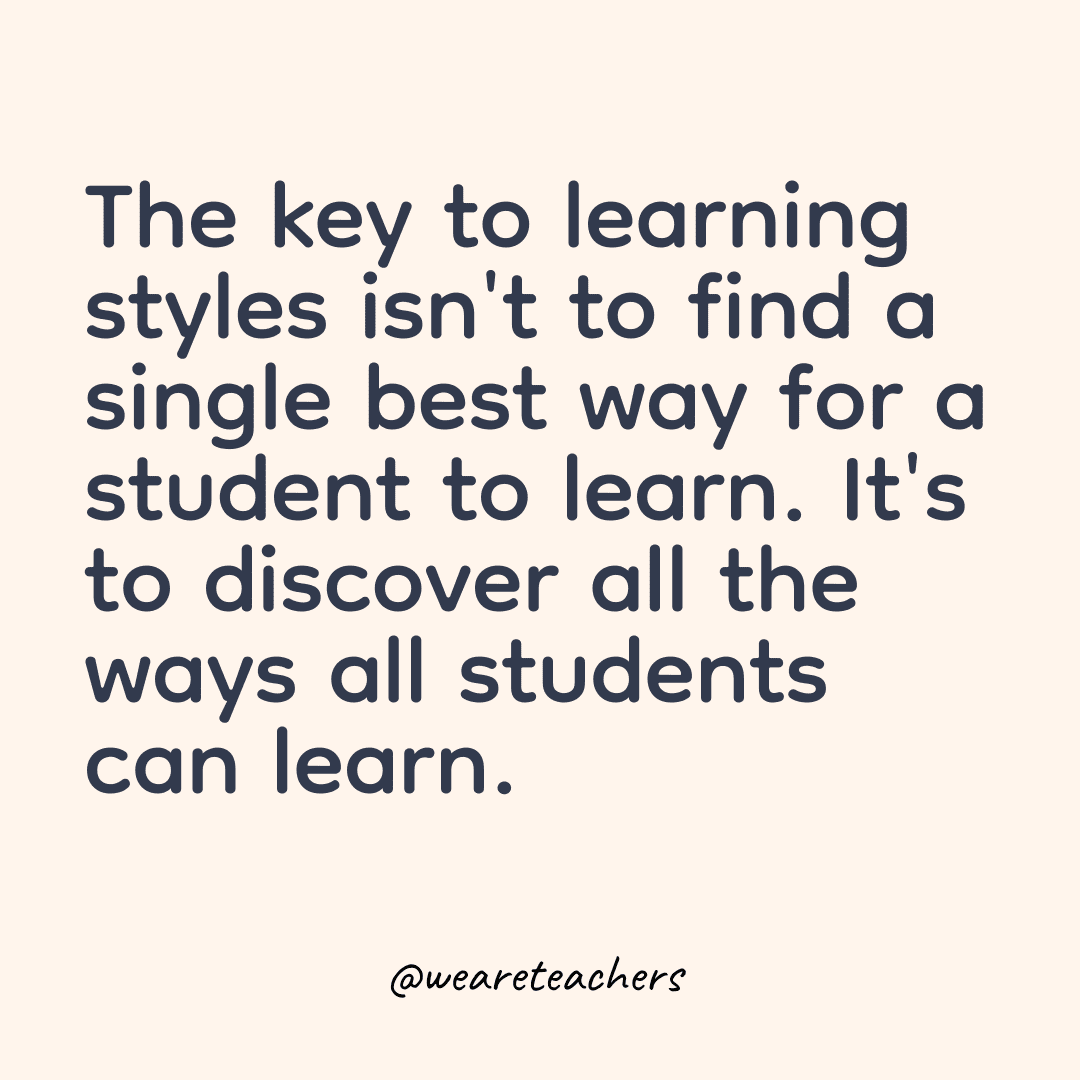
How should teachers use learning styles in the classroom?
The biggest takeaway for teachers is that they should design their curriculum with activities that fit all four learning styles. If you’re teaching students about earthquakes, plan to provide reading material, watch videos, explore diagrams, and do some hands-on classroom experiments. This array of activities allows all students to find a way of learning that suits them best.
Avoid classifying particular students as one type of learner, even if you note a particular preference. Rather than thinking of “visual learners,” think of “visual learning.” Encourage every student to explore material in a variety of ways, finding the methods that help them the most.
If a student is having trouble mastering material one way, offer alternatives. For instance, one student can’t seem to memorize their math facts. They spend time doing flash cards with their parents every day at home, but it’s just not sticking. Encourage the student to try something different. Maybe they can watch a video that sets the math facts to music. Or they might benefit from playing a matching game with the flash cards, or even hopping along the floor from one card to the next as they practice. Engage different senses in the process until you find one that brings the learning home.
The Four Learning Styles in the Classroom
Take a closer look at what the various learning styles look like in the classroom, and discover activities that support those styles.
Visual Learning
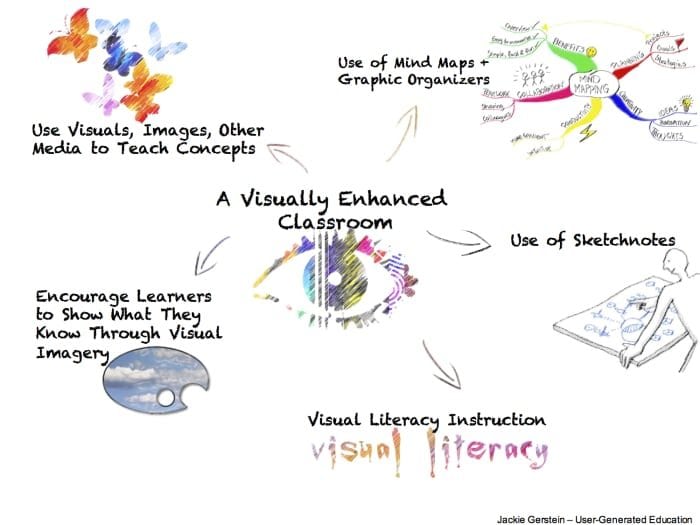
Source: TeachThought
When you’re learning visually, you’re engaging your eyes. These activities involve bright colors, graphic representations of concepts or materials, and lots of visual aids.
What It Looks Like:
- Diagrams, charts, graphs, and maps
- Videos, photos, and other images
- Drawing and doodling
- Interesting layouts and formats of written material
- Colors and shapes
Classroom Activities
- Math: Represent numbers and problems in a variety of ways, including pictures, 10-frames, videos, and diagrams
- Language Arts: Add images to support the text, like photos, charts, and maps; encourage students to make drawings representing what they read
- Science: Watch videos, look at pictures, analyze charts and diagrams
- Social Studies: Explore maps in detail, look at pictures, provide charts and diagrams, watch videos
Auditory Learning

Source: Argo Prep
Auditory (also called aural) learning is all about sound, both listening and talking. The more students get a chance to hear, say, and discuss the information, the better.
What It Looks Like:
- Audiobooks
- Videos with sound
- Music
- Text-to-speech translation
- Discussion and debate
- Asking and answering questions
- Teaching others
Classroom Activities
- Math: Sing songs to learn numbers or math facts, talk through problems out loud while solving them, repeat formulas out loud, watch math videos
- Language Arts: Read out loud (to self or others), listen to audiobooks, practice spelling words out loud
- Science: Watch videos with sound, learn songs about concepts, discuss ideas and experiments
- Social Studies: Debate or discuss a topic, read articles out loud, watch videos with sound
Read/Write Learning
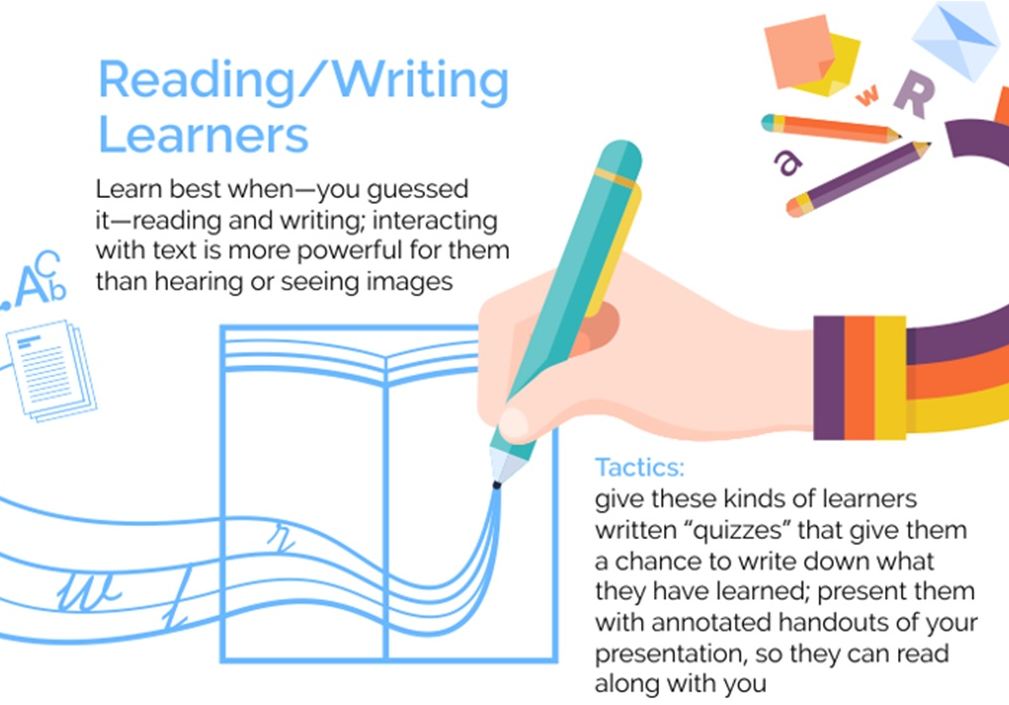
Source: Kwik Pass
As the name suggests, this style focuses on the written word. Whether reading or writing, it all comes down to seeing things in words on the page. Some people lump this modality with visual learning, but this style relies much more on written text than images.
What It Looks Like:
- Textbooks, articles, and handouts
- Video with subtitles turned on
- Essays and papers
- Speech-to-text translation and transcripts
- Making lists, with subheads, bullet points, etc.
- Taking detailed notes
- Writing answers to questions instead of answering out loud
Classroom Activities
- Math: Complete worksheets, write down math facts and formulas, turn numerical problems into word problems
- Language Arts: Read independently, write essays or answers to questions, take notes during discussions or lectures
- Science: Read texts and articles, watch videos with subtitles turned on, take detailed notes during hands-on experiments and activities, write down concepts in your own words during lectures
- Social Studies: Read texts and articles, watch videos with subtitles turned on, write answers to review questions, take detailed notes during lectures, provide transcripts of videos
Kinesthetic Learning
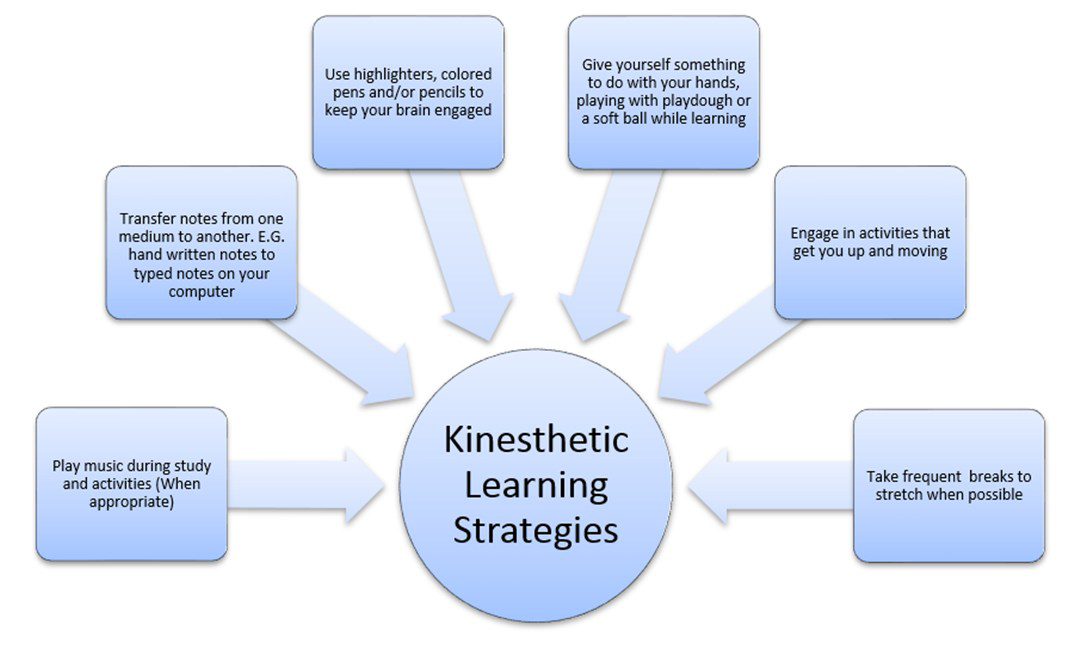
Source: Open Library
When you tie movement to learning, that’s the kinesthetic style. This modality involves lots of hands-on activities and the ability to try things for yourself. Dancing and even exercise can reinforce this type of learning.
What It Looks Like:
- Hands-on practice
- Educational craft projects
- Experiments and demonstrations
- Trial and error
- Exploring real-life examples of concepts and ideas
- Moving while learning
Classroom Activities
- Math: Play active math games (see a list here), practice counting while jumping or performing other movements, show how concepts apply in real-life situations, use lots of math manipulatives
- Language Arts: Read nonfiction and autobiographies, write letters in the air while spelling the words, perform a skit that summarizes a story, use active reading games (see a list here)
- Science: Complete hands-on demonstrations, design and perform experiments, apply the concepts to real life
- Social Studies: Visit museums and historic sites, draw timelines, reenact historical events, try the dances and arts of a culture
Next, try these 21 Differentiated Instruction Strategies Every Teacher Can Use.
Plus, get all the latest teaching tips and ideas when you sign up for our free newsletters!
